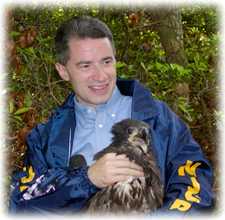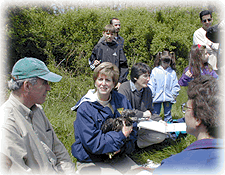 |
|
|||
Objectives
Materials Copies of the data sheet for Bear Swamp Writing materials Art supplies (optional) Making Connections Background The bald eagle population in New Jersey has increased from a single nest in the 1970’s and early 1980’s to fourteen active pairs in 1997. Endangered and Nongame Species Program (ENSP) biologists have monitored the nesting and wintering populations each year since 1980, and implemented a recovery strategy to increase the productivity and range of nesting, to bring the bald eagle back from the brink of extirpation. In 1982, after Bear Swamp, New Jersey’s only active bald eagle nest, had failed at least six consecutive years, ENSP biologists removed the egg for artificial incubation, and fostered the young back to the nest. This technique compensated for the contaminant problem that caused the eggshells to be too thin to withstand incubation. It was continued successfully until 1989, when the female of the pair was replaced and the pair was able to hatch their own eggs. Increasing the production from a single nest, however, was not enough to boost the state’s population in a reasonable amount of time. Mortality rates are high in young eagles (as much as 80%), and they do not nest until four or five years of age. The ENSP instituted a hacking project in 1983 that resulted in the release of 60 young eagles in New Jersey over an eight year period. (Hacking is the process of implanting healthy eggs [i.e., not contaminated with residual DDT] into the eagles’ nest.) These eagles have contributed to the increase in nesting pairs since 1990. Bald eagles nesting in New Jersey face many threats: disturbance is the greatest problem, as people are naturally attracted to the sight of eagles. Habitat destruction is also a common problem. Further, in the long term, there is evidence that accumulation of contaminants may threaten the eagle population in New Jersey, especially in the Delaware Bay region. ENSP biologists continually work to manage and reduce disturbance in eagle habitats, especially around nest sites. Education and established viewing areas are important in this effort, as are the efforts of eagle project volunteers. Biologists also work to protect habitat in a variety of ways, including working with landowners and land acquisition experts, and through the state’s land use regulations. The ENSP is continuing to investigate the possible impacts of organochlorines and heavy metals in eagles and other raptors nesting in the Delaware Bay region. Bald eagles, ospreys, and peregrine falcons nesting in the region exhibit some reproductive impairment relative to other areas. The ENSP monitors these species during the nesting season to evaluate nest success and assess any problems that occur. The population of wintering bald eagles has grown along with the nesting populations, especially in the last nine years. This growth reflects increasing nesting populations in New Jersey and the northeast, as each state’s recovery efforts pay off. In recognition of this success, the federal government upgraded the status of the bald eagle from endangered to threatened in July of 1995. The federal status change reflects the increasing eagle population nationwide, but the eagle is still a state-listed endangered species, and regulatory protection remains the same. All known nest sites are monitored January through July. Volunteer observers watch nests from a minimum distance of 400 yards using binoculars and spotting scopes, for periods of one to three hours (or more) each week. They record all data including number of birds observed, courtship or nesting behaviors, incubation and exchanges, feeding, and other parental care behaviors which provide valuable information on the nesting status. Dates are recorded for incubation, hatching, banding, fledging, and, if applicable, nest failure. This information is used to schedule eaglet banding, and to determine if closer nest investigation by ENSP biologists is warranted. For further information on the eagle project and a copy of the latest annual report, or other efforts for the protection and management of endangered species in New Jersey, contact the ENSP at (609) 292-9400. Ask for a copy of the films and videos they have available for schools to borrow. Specifically, Back from the Brink is a New Jersey Network special documentary that focuses on the bald eagle, osprey, and peregrine falcon and their recovery in New Jersey. Procedure Warm Up Discuss endangered species with the students. Have them research the causes of animals to become endangered. Can they name any endangered species? Tell them that the bald eagle is an endangered species in New Jersey. Have the students describe what a bald eagle looks like. Show pictures if available. Share some of the Background information with the class. Tell the class that there are bald eagles that nest in the Down Jersey region.
Wrap Up Each group should share their story with the rest of the class. This could mean simply putting them on display in the classroom, or having each group read aloud. These stories could also be presented using drama and props where group members act out the story. Action Find out about the “Adopt-A-Species” Program by calling the NJ Division of Fish, Game and Wildlife’s Endangered and Nongame Species Program at (609) 292-9400 and help a specific eagle’s nest (perhaps the one in Bear Swamp). Hold an “Endangered Species Awareness Fair” and educate the school and community about the endangered species of New Jersey and the Down Jersey region. Assessment Student participation in the graphing and question portion. Also, involvement and participation in the group activity of creating the story and its presentation. Extensions Have small groups of students (or as a class) brainstorm a list of possible threats to eagles and eagle nests in New Jersey (i.e.; encroaching development and land use such as a strip mall or residential neighborhood, proximity of the nest to road construction, unknowing photographers and bird watchers getting too close, dirt bikes using the trails through the woods, etc.). Now, come up with a scenario where an eagle nest is being threatened by several of the things from the list generated. A map may be drawn to model the nest and surrounding vicinity. Challenge the students to hypothesize various ways to solve the problems that threatened the productive success and well being of the eagle nest. This could be developed further with students role playing a town meeting to address the issues. Also see Action at left. Please download the PDF for the complete Lesson Plan. New Jersey Division of Fish, Game and Wildlife, Endangered and Nongame Species Program The Raptor Center has some wonderful resources. Check out their lesson plans by visiting their website at http://www.raptor.cvm.umn.edu/newwebdev/meeen/meeen/connect.html Find out more about the local efforts currently going on to protect other endangered and threatened species in your area. Utilize the plans included and build an osprey platform and donate it to a group that will install it. New Jersey Audubon Society |
|||

 Duration
Duration The Activity
The Activity  Tell the students that every known nest in New Jersey is monitored from January through July. Volunteer observers watch nests from a minimum distance of 400 yards using binoculars and spotting scopes, for periods of one to three hours (or more) each week. They record all data including number of birds observed, courtship or nesting behaviors, incubation and exchanges, feeding, and other parental care behaviors which provide valuable information on the nesting status. Tell the students that they are now going to pretend that they are the nest observers for the Bear Swamp nest.
Tell the students that every known nest in New Jersey is monitored from January through July. Volunteer observers watch nests from a minimum distance of 400 yards using binoculars and spotting scopes, for periods of one to three hours (or more) each week. They record all data including number of birds observed, courtship or nesting behaviors, incubation and exchanges, feeding, and other parental care behaviors which provide valuable information on the nesting status. Tell the students that they are now going to pretend that they are the nest observers for the Bear Swamp nest.